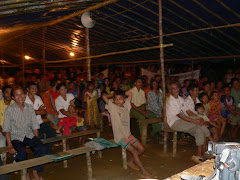Sentarum, exotic wet swampy lake in West Kalimantan
The
By Erma S. Ranik
Located in Kapuas Hulu district, some 700 km from
Sentarum is unique in that some 35,000 hectares of the lake is 7 meters to 15 meters in depth with the remainder a swampy forest with tree heights measuring 20 meters to 25 meters.
The tropical rain forest is much thicker than any other forests elsewhere in the province. Sentarum is the only primary fresh water swampy forest area in
The trees adapt to the high level water levels that flood the area annually. Although the annual flood from December to March rises as much as 7 meters, the trees manage to survive.
When the dry season comes, usually in July or August, the water level of River Kapuas goes down. The swamp and part of the lake dries up.
""The land will seem just like a meadow,"" said Hariyanto, a local resident.
This meadow, he added, is prone to fire. ""There was a big fire in Sentarum back in the 1997 dry season,"" he said.
Research conducted by Kleper shows that peat surrounds the lake and the land is lacking in minerals and the water in the lake becomes tea-brown owing to the presence of tannin in great amounts.
There are also fancy fish like ulanguli (botia macranthus) and the expensive rare species, arwana (scleropages formosus). Unfortunately, Arwana is difficult to find in
The lake area is also home to proboscis monkeys (sasalis larvatus), orangutans (pongo pygmaeus), sinyulong crocodiles (tomistoma schlegelii), estuary crocodiles (crocodylus prosus) and swampy forest egrets (ciconia stromi), among others.
The area is rich in tembesu wood (fragrea fragrans) and kawi (shorea balngeran) as well as 207 other varieties of plants.
The uniqueness of this lake area prompted the government to decide in 1982 that
Untapped potential
""There seems to be a tug-of-war between the interests of the central government and those of the regional administration,"" said Sumiati, head of the sub-section for technical guidance of
In fact, Sentarum has a lot to offer: the beauty of its flora and fauna and its unique culture.
You can see enggang gading, a rare bird now the mascot of
Visitors can enjoy delicious fresh water fish. You can buy them from the locals or you can catch them yourself.
Do you like swimming? You can spend as much time as you want swimming in the lake. Although the water is brown in color, it is clean. But be careful because in some parts of the lake there are still swamp crocodiles.
Then you can go to the cave at Semujan Hill where you can see seagull nests. Black seagull nests are found in this limestone hill. A kilogram of the nests may bring a price of Rp 2.5 million to Rp 4 million and the nests can be harvested every 2 months.
As seagull nests are valuable, the owners of the nests usually guard the cave during harvest time. If you like rock climbing, you may take part in the harvest.
It is also interesting to observe the culture of the locals, who are from sub-tribes of Dayak Iban, Dayak Embaloh, Dayak Kantuk and Malay.
The Malays live in the river basin areas. They are Muslim and their houses float on the river. To connect one house with another there is a wooden bridge. For many generations, the Malays have survived on the fish of
""We never till the land,"" said Hariyanto, a resident of Nanga Leboyan, Selimbau sub-district. He said that they bought rice and vegetables from the Dayak people.
There is a saying: ""There are no vegetables if there are no Iban people,"" he added with a smile.
The Malays also traditionally collect honey from wild bees (apis dorsata) found in trees around the lake. If you come to this area in October or early November or between mid-January and end of February, you can enjoy the honey along with the locals.
The Dayak people are usually Christian and live in hilly areas in their traditional communal long houses. These houses may be dozens of years to hundreds of years old. Within the lake area there are at least eight long houses.
In their long houses, the Dayak people lead their social and cultural lives. If you are lucky and come during the Gawai (festivity) season, they will be pleased to ask you to dance to the Sapek music, the traditional music of the Ibans. You can then enjoy tuak, a liquor unique to the Dayak people.
If your time is plenty, you can spend a few days in a long house and observe how the traditional cloth of the Dayak Iban is made. The cloth is woven by the women and is colored with plant material. Then traditional patterns are drawn on the cloth.
Remember that you may not be able to see one of these traditional cloths of the Dayak Iban because each one takes about a year to make. That's why it is expensive and may cost hundreds of thousands of rupiah. ""But the quality is very good,"" said Valentinus Hery, a Dayak Iban.
Interestingly, in an outer region of the lake there is a small island called
Once you finish sailing round the lake, you can learn to steer a boat with an outboard engine. Locals are usually willing to show you how to do this. Who knows, after some time you may be able to steer the boat adeptly. Be careful, though, because during the wet season, the weather on the lake area capricious. Strong winds followed by a downpour may occur at any time. If caught in such a storm, it would be prudent to take your boat to the bank and take refuge among the trees around the lake.
Then you can feast your eyes on the panorama of Sentarum. You can climb Bukit Terkenang. This is the highest hill in the area. From the tower at the top you can see the lake area in its entirety. There used to be a research center project on this hill -- a joint undertaking between the Indonesian and British governments. Unfortunately, the project, which was not completed, is in great neglect. There are lodging places for visitors but the facilities are not proper.
At night it is an almost spiritual experience to sit quietly in the middle of the lake and enjoy its beauty. The magnificence of the star-studded night sky and the serenity engendered by the night sounds of nature will make you feel compelled to return to this place, again and again.
The natural beauty of
How to get there
The trip to the lake is not difficult, but it is arduous. You can take a bus from
Alternatively, you can fly from Supadio airport in
If you take a speedboat, the cost will be higher but the advantage is that you can directly reach the lake. If you take a bus, you will spend less money but you will still have to take a speedboat to reach Lanjak.
Arriving at
To explore the entire area by boat would take at least a week, but you would certainly not regret the time. The vistas, flora and fauna will intrigue you and provide you with memories that will undoubtedly make you return one day.





Tidak ada komentar:
Posting Komentar